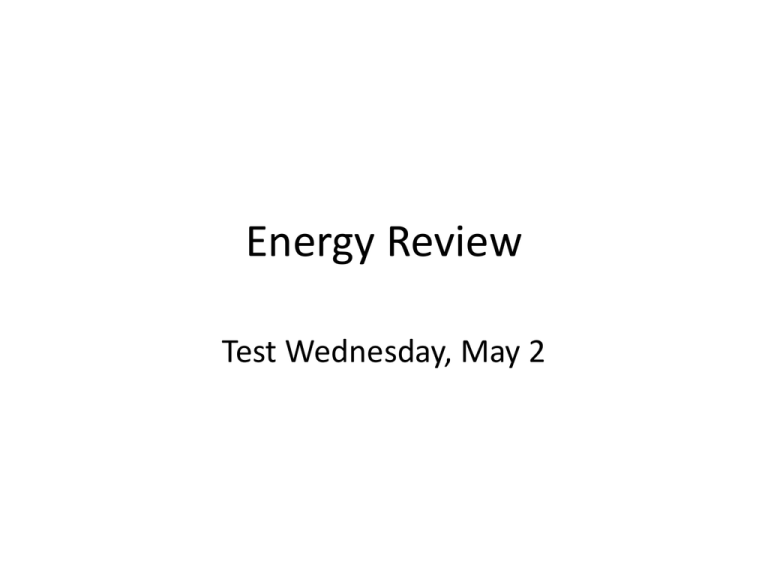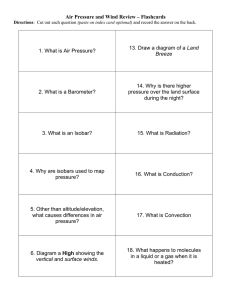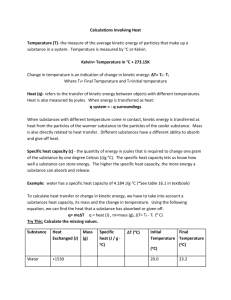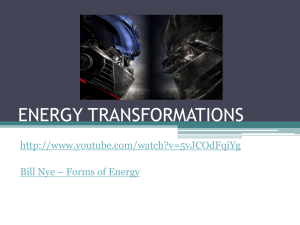Energy Review
advertisement

Energy Review Test Wednesday, May 2 1. What are the units of energy? Joules 2. The kinetic energy of an object increases when its _____ a. speed increases b. volume increases c. height above the ground increases 3. According to the kinetic theory of matter, as air gets hot, the air _____. a. expands and sinks b. contracts and rises c. expands and rises d. contracts and sinks 4. List two materials that become hot easily. Aluminum, copper, brass, iron, etc 5. List two materials that do not become hot as easily as the materials listed in 4. ceramic, glass, water, etc 6. If a block of metal at 10°C is placed next to a block of metal at 40°C on a table that is in a room at room temperature, which of the following is likely to happen? a. The cooler block will become cooler. b. The hotter block will become hotter. c. Each block will stay at its original temperature. d. The hot block will cool and the cool block will become hotter. 7. Which of the following does not require an input of energy? a. raising the temperature b. evaporation c. condensation d. melting 8. If the same amount of energy is added to 5 g of water and to 50 g of water, which sample will have the higher temperature? The 5 grams of water will have a higher temperature since there is less mass the same amount of energy will cause more molecular motion and therefore a higher temperature 9. What provides energy, as heat, to the sea and land? The Sun! 10. Which has the highest specific heat value—land or water? Explain. The water has a higher specific heat value since it takes more energy to raise the temperature of a kilogram of water 1oC. 11. Complete the diagram below to illustrate the movement of air that creates a land breeze. Add arrows and labels as appropriate. Use the sea breeze diagram, shown above, as a model. 12. As the temperature of mercury inside the thermometer increases, its volume increases. T / F 13. On the Fahrenheit scale water freezes at –32oF. T / F 14. A degree on the Fahrenheit scale is a bigger unit than a degree on the Celsius scale. T / F 15. Energy is transferred as heat between two objects at the same temperature. T / F 16. Energy is transferred as heat from a substance at high temperature to a substance at low temperature. T / F 17. Heating by convection can occur through solids, liquids, or gases. T / F 18. Radiation is the only method of energy transfer that can take place in a vacuum. T / F 19. Some substances, when exposed to visible light, absorb more energy as heat than other substances. T / F 20. A good insulator is a poor conductor. T / F 21. Insulation minimizes undesirable energy transfers. T / F 22. How much the temperature of an object increases when energy is transferred depends only on the mass of the object. T / F 23. People feel most comfortable when the temperature of the air is 98.6oF. T / F 24. Energy as heat flows from a lower temperature to a higher temperature. T / F 25. The transfer of energy as heat caused by the collision of molecules is called CONDUCTION 26. The transfer of energy by the movement of fluids or gases with different temperatures is called CONVECTION 27. Energy from the sun reaches Earth by ______. RADIATION 28. Convection currents rise in air because of _____. DENSITY DIFFERENCES 29. Which method of energy transfer does not involve movement of matter? RADIATION 30. Suppose a fixed number of joules of energy as heat is added to 1 g of a substance. For which substance will the rise in temperature be the least? WATER 31. _____is a measure of the average kinetic energy of all the particles within an object. TEMPERATURE 32. A(n) _______ is a device for measuring temperature. THERMOMETER 33. ___________ is a hypothetical temperature where all motion ceases. ABSOLUTE ZERO 34. The energy transferred between the particles of two objects because of the temperature difference between the two objects is called ______. HEAT ENERGY 35. _______________________ is the ability to do work. 36. List 3 examples of convection, conduction and radiation. BOILING WATER WIND SEA BREEZE LAND BREEZE AIR CONDITIONING COOKING IRONING HAIR STRAIGHTER REPTILE SUNNING SUN MICROWAVE TOASTER HEAT FROM FIRE 37. If a substance has a high specific heat, what information does that provide to you? Low specific heat? It takes more energy to change the temperature of an object with a high specific heat value than one with a low specific heat value. 38. Make a list of substances that are considered insulators and conductors. Aluminum Iron Down Wool Mercury Copper Glass Air Steel Styrofoam Plastic ANY METAL!! Wood Fiberglass




